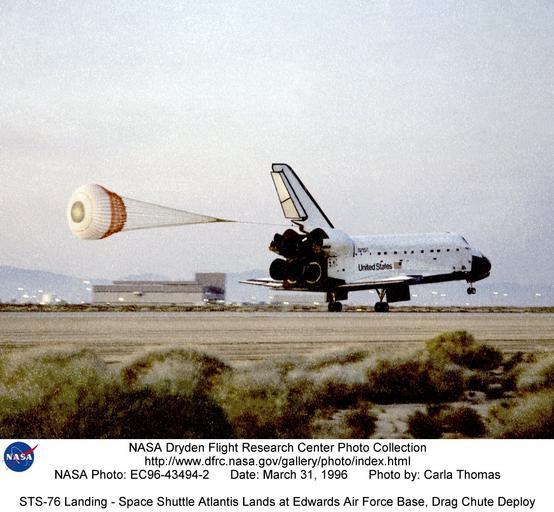MAKE A MEME
View Large Image

| View Original: | STS-76_Landing_-_Space_Shuttle_Atlantis_Lands_at_Edwards_Air_Force_Base,_Drag_Chute_Deploy_DVIDS737359.jpg (1536x1419) | |||
| Download: | Original | Medium | Small | Thumb |
| Courtesy of: | commons.wikimedia.org | More Like This | ||
| Keywords: STS-76 Landing - Space Shuttle Atlantis Lands at Edwards Air Force Base, Drag Chute Deploy DVIDS737359.jpg en The space shuttle Atlantis touches down on the runway at Edwards California at approximately 5 29 a m Pacific Standard Time after completing the highly successful STS-76 mission to deliver Astronaut Shannon Lucid to the Russian Space Station Mir She was the first American woman to serve as a Mir station researcher Atlantis was originally scheduled to land at Kennedy Space Center Florida but bad weather there both 30 and 31 March necessitated a landing at the backup site at Edwards This photo shows the drag chute deployed to help the shuttle roll to a stop Mission commander for STS-76 was Kevin P Chilton and Richard A Searfoss was the pilot Ronald M Sega was payload commander and mission specialist-1 Mission specialists were Richard Clifford Linda Godwin and Shannon Lucid The mission also featured a spacewalk while Atlantis was docked to Mir and experiments aboard the SPACEHAB module Space Shuttles are the main element of America's Space Transportation System and are used for space research and other space applications The shuttles are the first vehicles capable of being launched into space and returning to Earth on a routine basis Space Shuttles are used as orbiting laboratories in which scientists and mission specialists conduct a wide variety of scientific experiments Crews aboard shuttles place satellites in orbit rendezvous with satellites to carry out repair missions and return them to space and retrieve satellites and return them to Earth for refurbishment and reuse Space Shuttles are true aerospace vehicles They leave Earth and its atmosphere under rocket power provided by three liquid-propellant main engines with two solid-propellant boosters attached plus an external liquid-fuel tank After their orbital missions they streak back through the atmosphere and land like airplanes The returning shuttles however land like gliders without power and on runways Other rockets can place heavy payloads into orbit but they can only be used once Space Shuttles are designed to be continually reused When Space Shuttles are used to transport complete scientific laboratories into space the laboratories remain inside the payload bay throughout the mission They are then removed after the Space Shuttle returns to Earth and can be reused on future flights Some of these orbital laboratories like the Spacelab provide facilities for several specialists to conduct experiments in such fields as medicine astronomy and materials manufacturing Some types of satellites deployed by Space Shuttles include those involved in environmental and resources protection astronomy weather forecasting navigation oceanographic studies and other scientific fields The Space Shuttles can also launch spacecraft into orbits higher than the Shuttle's altitude limit through the use of Inertial Upper Stage IUS propulsion units After release from the Space Shuttle payload bay the IUS is ignited to carry the spacecraft into deep space The Space Shuttles are also being used to carry elements of the International Space Station into space where they are assembled in orbit The Space Shuttles were built by Rockwell International's Space Transportation Systems Division Downey California Rockwell's Rocketdyne Division now part of Boeing builds the three main engines and Thiokol Brigham City Utah makes the solid rocket booster motors Martin Marietta Corporation now Lockheed Martin New Orleans Louisiana makes the external tanks Each orbiter Space Shuttle is 121 feet long has a wingspan of 78 feet and a height of 57 feet The Space Shuttle is approximately the size of a DC-9 commercial airliner and can carry a payload of 65 000 pounds into orbit The payload bay is 60 feet long and 15 feet in diameter Each main engine is capable of producing a sea level thrust of 375 000 pounds and a vacuum orbital thrust of 470 000 pounds The engines burn a mixture of liquid oxygen and liquid hydrogen In orbit the Space Shuttles circle the earth at a speed of 17 500 miles per hour with each orbit taking about 90 minutes A Space Shuttle crew sees a sunrise or sunset every 45 minutes When Space Shuttle flights began in April 1981 Dryden Flight Research Center Edwards California was the primary landing site for the Shuttles Now Kennedy Space Center Florida is the primary landing site with Dryden remaining as the principal alternate landing site NASA Identifier NIX-EC96-43494-2 2009-09-23 Glenn Research Center https //www dvidshub net/image/737359 737359 2012-10-17 23 02 WASHINGTON DC US PD-USGov Landing of STS-76 Images from DoD uploaded by Fæ Space Shuttle parachutes | ||||